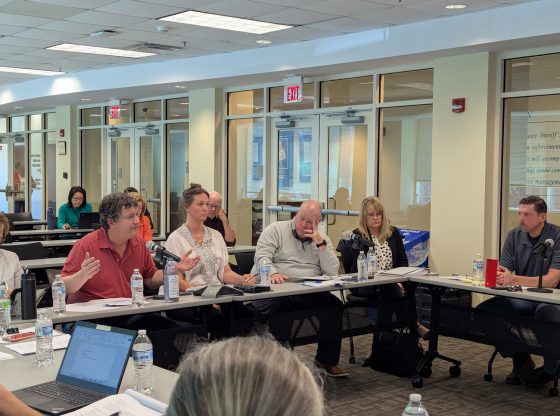On March 12, for the first time since 2016, the Moore County Board of Commissioners and the Board of Education Collaboration Committee met to discuss capital projects and the budget. Several members from each team attended.
Priority Discussion
By the end of the meeting, the two groups agreed their number one priority was Carthage Elementary School.
Capital funds build or maintain capital assets, such as buildings.
Operational funds cover salaries, benefits, contracted services, and overhead costs, such as electricity, supplies and equipment.
“We are 1,000 students over capacity right now between Union Pines and Pinecrest. Now, our board has not decided yet. Do they want to do the renovations or expansion, or do they want a new high school? I’m presenting to them on the 26th [of March] so they can get some clarity and decide which way they’re going. But that is going to be number two,” Assistant Superintendent for Operations Jenny Purvis said about the two high schools being the second priority, and everyone agreed.
The board of education is partnering with a realtor in April and will present a parcel of 22 to 25 acres of land for Carthage Elementary School to the commissioners for consideration.
School Board Member David Hensley made three suggestions. He suggested a military-style strategic planning process, to use hotel occupancy tax funds exceeding the current $4 million for schools, and to establish school buildings and their meals and labor forces for disaster relief.
Planning Process Discussion
Commissioner Chair Kurt Cook agreed with strategic planning, but it needed to include operational planning for a parallel planning process.
“You know, the school board has literally for the last six years come up with a 10-year strategic plan that predates me with a price tag of $450 million. But I don’t recall any discussions with the county commissioners or the public. How are we gonna pay for this and talk about it in total rather than piecemeal?” Hensley said about finding funding sources.
Innovative High School Discussion
With a $450 million request for school improvements and new construction, the “new” innovative high school, which will be on the campus of Sandhills Community College (SCC), garnered much discussion.
Moore Innovative High School (IHS) was implemented without input from governing bodies, according to Hensley, who said if consulted, would have recommended its construction in combination with a new, more centrally located high school or its integration with an existing high school. This would have saved money on land costs, construction, and transportation.
IHS allows 100 students per grade for a total of 300 for a wrap-around education to help students achieve better outcomes.
North Carolina has 134 innovative high schools, with one in Wake County where Moore County Superintendent Tim Locklair previously served as a superintendent.
Although IHS describes its school as “accelerated,” because students shove four years of school into two, some believed “accelerated” is a misuse of the word.
According to Hensley, Moore County Schools (MCS) and SCC both receive full state funding, $12,000 per year per student, for the same students, and after high school graduation, they attend SCC for classes, but MCS still gets $12,000 per year for each of those students.
For 300 students at $12,000 per year for two years, the total is $7,200,000.
“Why are we making a votech [innovative high school] school when my kids’ classroom walls are falling down in Pinecrest? Why are they thinking about doing this for 300 students when we have the rest of the schools going down, falling apart around their feet?” Cook asked about Moore Innovative High School, which is for students at risk of dropping out and focuses on skilled jobs, such as welding.
“Sometimes we get unexpected opportunities, and I don’t know all of the conversations that happened that got us an opportunity like this [innovative school] to collaborate with our community college and just build a new program,” Moore County School Board Chair Dr. Robin Calcutt said about working with Sen. McInnis.
Hensley said leaders on the board have not disclosed plans or costs for the IHS expansion, the advanced career center, or amphitheater. They launch the new high school in five months, and do not know the cost of the buildings, or who pays, or if funding is even available, said Hensley in an email to Sandhills Sentinel.
In a March 4 press release, McInnis noted that North Carolina has been recognized as the No. 1 or No. 2 state for business for the past three years, bringing a surge in job demand. By 2031, there are projected to be 576,000 annual job openings in the state and 68% of those will require a postsecondary or high-quality credential.
McInnis presented Senate Bill 223 in March 2025, and it passed its third legislative session reading March 12. The bill expands technical school entry to sophomores. This may complicate enrollment capacity because only 100 students per grade are allowed in IHS.
“We placed 10 out of 115 school districts last year in career credentials and certifications. We’re very proud to be a top ten school. We have a great career technical education program,” Locklair said about the new innovative high school.
Expanding alternative education, Cook said he currently attends Liberty University online, said virtual learning was great, and requested the operational costs for the county’s virtual school, Connect Academy.
Funding Discussion
The two teams discussed the appropriation of operational funds.
“Here’s the bombshell. The county is really funding most of our empty positions because the state won’t pay for empty positions. The bottom line is Moore County Schools has [vacant] teacher positions we’re getting paid for, and we’re using it for other purposes,” Hensley said.
“We reinvest our vacancy savings into the next budget that banks another fund balance that we have to assign to, then have a balanced budget for next year. These savings we have and what our budget is that we don’t have to use assigned fund balance,” Locklair said about not agreeing with Hensley’s wording.
“That doesn’t make sense. If that was happening, it should be adding upon each year. If you took this year, and you say you don’t have the next year, but you don’t use it next year, it should be added too, not replace when you have increased local cost. Every year that deepens that whole,” Commissioner Nick Picerno said.
School enrollment increased by 37 students per year over the last seven years, with the most growth in charter schools.
The school system currently needs 38 more teachers.
The Moore County Schools’ student-to-teacher ratio is 1/91, but at the IHS, under General Assembly’s mandates, the ratio is 1/20.
Learn more about IHS regulations here and here.
Hotel Occupancy Tax Discussion
The board of commissioners meets March 18 for a public hearing to discuss a hotel occupancy tax rate increase, and the two teams will further the discussion on using revenue over the current $4 million for schools.
Disaster Relief Discussion
The proposal to designate schools and their resources during disasters was a heartwarming idea, and the comparison of “Grapes of Wrath” added pathos to the discussion, according to responses, but federal funding concerns left the discussion at a standstill.
If the 90,000 lunches spoiled, the federal government would provide a subsidy for replacement, but if they were fed to citizens during a disaster, the school system would not receive anything. The meals add up to $453,000. The cost of lunchroom staff, janitors, and bussing skyrocketed the amount to at least a million.
The teams will continue disaster relief discussions.
Budget Discussion
Because the allotted time for the meeting ran over, the board of education provided handouts on the budget.
Locklair hand-marked the following items as his priorities:
*The impact of fixed cost increases; “Taking care of our people so they can take care of our students.”
*Potential expansion items advocated by the board, and include “unfreezing” of the curriculum specialist position.
*Utilizing a “lean budget approach” to moderate the local budget’s impact on the use of fund balance:
- Reinvesting vacancy savings
- Finding budget efficiencies
- Conservatively projecting revenues from our county funding formula
- Estimating fixed cost increases based on historical data
The two teams said they would like to continue collaborating with meetings every other month.
Feature photo: Moore County Board of Education member David Hensley, Vice Chair Shannon Davis, Superintendent Tim Locklair, and Finance Director Tina Edmonds, and Moore County Commissioner Chair Kurt Cook discuss capital projects March 12, 2025, at the Rick Rhyne Center in Carthage.
~Article and photo by Sandhills Sentinel journalist Stephanie M. Sellers. Stephanie is also an English instructor at Central Carolina Community College. Her fictional work includes When the Yellow Slugs Sing and Sky’s River Stone, and a suspense, GUTTERSNIPE: Shakespearean English Stage Play with Translation, and a March 21, 2025, release published by Golden Storyline Books, a science fiction, Amagi.
To sign up for the free Sandhills Sentinel breaking news and weekly e-newsletter, please click here.



















